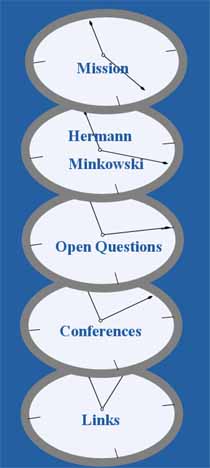 |
|
|
|
 |

|
|
Spacetime or space?
Oliver Pooley
My question is related to Vesselin Petkov's Relativity and the Dimensionality of the World. He asks whether the
spacetime of special relativity is a way of representing a
fundamentally 3-dimensional world evolving in time, or whether our
world is a world of fundamentally 4-dimensional spatiotemporally
extended objects. This is a question asked within the standard
mathematical framework of special relativity. It is a question
about the proper interpretation of that framework.
But the question whether space or spacetime is fundamental also
arises in a different context: the quantization of general
relativity. The starting point of the canonical quantization
programme is the casting of general relativity into a 3+1
Hamiltonian form, as a theory about the evolution of the geometry of
3-dimensional space over time (Arnowitt, Deser and Misner 1962).
This formalism is not by itself incompatible with the view that
spacetime is fundamental. It merely shows that one can
completely characterize the 4-dimensional geometry of the world in
terms of the variation of the geometry a family of 3-dimensional
hypersurfaces through spacetime. The arbitrariness of which family
of hypersurfaces is chosen can even be taken to support the view
that spacetime, not space, is the ultimate reality.
But Julian Barbour has advocated an interpretation of classical
general relativity according to which 3-space, rather than
spacetime, is the fundamental entity. His interpretation is partly
motivated by two very suggestive theoretical results. First, in
work he calls ``relativity without relativity'', he and
collaborators have shown that only a very few actions from a large
class of Hamiltonian theories that are natural from a 3-space point
of view turn out to be consistent. The consistent actions include
those which allow the construction of a 4-dimensional spacetime
geometry. In other words, mathematical consistency alone (almost)
gives you an effective spacetime geometry from 3-space principles
(Barbour et al. 2002; Anderson 2003).
The second result involves formulating geometrodynamics on a
configuration space of conformal three-geometries, rather than the
standard configuration space of Riemannian 3-geometries (Anderson et
al. 2003; Anderson et al. 2004). In such theories, one has a
uniquely preferred foliation of the resulting spacetimes. The
availability of such a foliation would seem to greatly enhance the
viability of an interpretation that takes a 3-space
geometrodynamical formulation of a theory as a better reflection of
fundamental ontology than a spacetime formulation.
Barbour has offered a sketch of an interpretation of quantum general
relativity that is in line with these classical results (Barbour
1994). There are other interpretations that are compatible with
viewing space as more fundamental than spacetime (Page and Wootters
1983). However, others are pursuing approaches to quantum gravity
that take spacetime's causal structure as fundamental (Markopoulou
and Smolin 1997; Reisenberger and Rovelli 1997; Sorkin 1997). So the
question is which will quantum gravity show to be more fundamental:
space or spacetime?
References:
R. Arnowitt, S. Deser, and C. Misner (1962), `The Dynamics of
General Relativity' in `Gravitation: an Introduction to Current
Research', ed. L. Witten, (Wiley, New York, 1962).
J. Barbour, B. Foster, and N. O'Murchadha (2002), `Relativity without
relativity', Classical and Quantum Gravity 19: 3217--48; gr-qc/0012089
E. Anderson (2003), `Variations on the Seventh Route to Relativity',
Physical Review D 68: 104001; gr-qc/0302035.
E. Anderson, J. Barbour, B. Foster, N. O'Murchadha (2003),
`Scale-Invariant Gravity: Geometrodynamics' , Classical and Quantum
Gravity 20: 1571; gr-qc/0211022.
E. Anderson, J. B. Barbour, B. Foster, B. Kelleher, N.
O'Murchadha (2004), `A first-principles derivation of York scaling
and the Lichnerowicz-York equation'; gr-qc/0404099.
J. B. Barbour (1994), `The Timelessness Of Quantum Gravity. II: The
Appearance Of Dynamics In Static Configurations', Classical and
Quantum Gravity 11: 2875-97.
D. Page and W. K. Wootters (1983), `Evolution Without Evolution:
Dynamics Described by Stationary Observables', Phys. Rev. D 27:
2885.
F. Markopoulou and L. Smolin (1997), `Causal Evolution of Spin
Networks', Nuclear Physics B 508: 409--30; gr-qc/9702025.
M. Reisenberger and C. Rovelli (1997), `Sum over Surfaces form of
Loop Quantum Gravity', Physical Review D 56: 3490--508;
gr-qc/9612035.
R. D. Sorkin (1997), `Forks in the Road, on the Way to Quantum
Gravity', International Journal of Theoretical Physics 36: 2759--81;
gr-qc/9706002.
|
|
|
 |
|
 |
